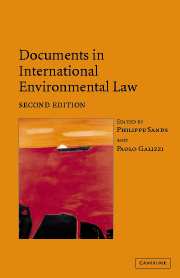Book contents
- Frontmatter
- Contents
- Preface
- PART I General instruments
- PART II Atmosphere
- PART III Oceans: global
- PART IIIB Oceans: regional
- PART IV Freshwater resources
- PART V Biodiversity
- PART VIA Hazardous substances and activities: nuclear
- PART VIB Hazardous substances and activities: pesticides
- PART VIC Hazardous substances and activities: waste
- PART VII Human rights and the environment
- PART VIII War and the environment
- PART IX Trade and the environment
- PART X Environmental impact assessment and access to information
- 38 Convention on Environmental Impact Assessment in a Transboundary Context, 25 February 1991
- 38A Protocol on Strategic Environmental Assessment, 21 May 2003
- 39 Convention on the Transboundary Effects of Industrial Accidents, 17 March 1992
- 40 World Bank Operational Policy 4.01 on Environmental Assessment, January 1999
- 41 Convention on Access to Information, Public Participation in Decision-Making and Access to Justice in Environmental Matters, 25 June 1998
- 41A Compliance Committee and Procedures for the Review of Compliance
- 41B Protocol on Pollutant Release and Transfer Registers, 21 May 2003
- PART XI Liability for environmental damage and breaches of environmental obligations
- PART XII The Antarctic
38 - Convention on Environmental Impact Assessment in a Transboundary Context, 25 February 1991
Published online by Cambridge University Press: 05 June 2012
- Frontmatter
- Contents
- Preface
- PART I General instruments
- PART II Atmosphere
- PART III Oceans: global
- PART IIIB Oceans: regional
- PART IV Freshwater resources
- PART V Biodiversity
- PART VIA Hazardous substances and activities: nuclear
- PART VIB Hazardous substances and activities: pesticides
- PART VIC Hazardous substances and activities: waste
- PART VII Human rights and the environment
- PART VIII War and the environment
- PART IX Trade and the environment
- PART X Environmental impact assessment and access to information
- 38 Convention on Environmental Impact Assessment in a Transboundary Context, 25 February 1991
- 38A Protocol on Strategic Environmental Assessment, 21 May 2003
- 39 Convention on the Transboundary Effects of Industrial Accidents, 17 March 1992
- 40 World Bank Operational Policy 4.01 on Environmental Assessment, January 1999
- 41 Convention on Access to Information, Public Participation in Decision-Making and Access to Justice in Environmental Matters, 25 June 1998
- 41A Compliance Committee and Procedures for the Review of Compliance
- 41B Protocol on Pollutant Release and Transfer Registers, 21 May 2003
- PART XI Liability for environmental damage and breaches of environmental obligations
- PART XII The Antarctic
Summary
Editorial note
The Convention on Environmental Impact Assessment in a Transboundary Context, which was adopted under the auspices of the UNECE, is designed to promote co-operation between States whose environmental, cultural or socioeconomic conditions are likely to be affected (referred to as ‘transboundary impact’ in Article 1(viii)) by another State's activities.
The Convention requires States to carry out an environmental impact assessment procedure for all activities listed in Appendix I that are likely to have a ‘significant adverse transboundary impact’ (Article 2(2)). That procedure is to allow for public participation and must result in production of the environmental impact assessment documentation set out in Appendix II (Article 2(2)). Environmental impact assessments as described in the Convention are required for all activities listed in Appendix I which are likely to cause ‘significant adverse transboundary impact’ (Article 2(3)). Parties may decide, by mutual consent, to extend the Convention's application to activities not listed in Appendix I but which are likely none the less to cause a ‘significant adverse transboundary impact’ (Articles 2(5) and 3(7)). Criteria for determining ‘significant adverse impact’ are set out in Appendix III of the Convention (Article 2(5)). States planning an activity likely to cause a ‘significant transboundary environmental impact’ are required to notify other States likely to be affected of the proposed project (Articles 2(4) and 3(1)) and allow the public of affected States to participate in the environmental impact assessment procedure in the same manner as its own public (Article 2(6)).
- Type
- Chapter
- Information
- Documents in International Environmental Law , pp. 1023 - 1041Publisher: Cambridge University PressPrint publication year: 2004



